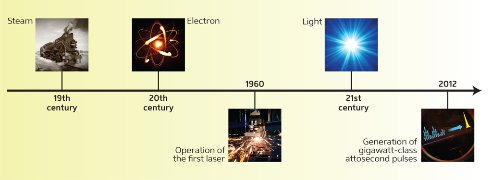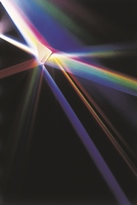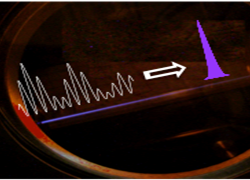Feb. 21, 2014 Perspectives Physics / Astronomy
Making the invisible visible
Photonics is indispensable for sustaining modern society, and its applications lead to breakthroughs in healthcare, advanced manufacturing, metrology, security and sensing.
Katsumi Midorikawa
Director
RIKEN Center for Advanced Photonics
Photonics, the science and technology of light, is not only a fascinating and important topic for basic research but is also indispensable for sustaining modern society. Applications developed in this area are the foundation of many breakthroughs in healthcare, advanced manufacturing, metrology, security and sensing. The importance of such applications is inspiring researchers in the field to further push the possibilities of light.
 Figure 1: The century of light. © 2014 RIKEN
Figure 1: The century of light. © 2014 RIKEN
Light is a packet of photons with increasingly important applications for both the scientific community and general public. For example, photonics researchers are harnessing photons as a means to visualize the motion of electrons in materials, as well as for use as noninvasive biological probes in medical imaging in humans. The use of photons has even revolutionized the way we send and store digital data, cost-effectively manufacture complex devices and generate electricity.
Photonics has also infiltrated our everyday lives. For instance, the circuit board of your cellular phone is likely to have been drilled by a laser and your car was probably laser welded. Using the Internet or sending an e-mail employs photons to carry the information. A hospital visit can involve x-ray cameras and optical endoscopes to look inside your body. If the nineteenth century was the century of steam and the twentieth century was the century of the electron, the twenty-first century will be remembered as the century of light (Fig. 1).
A century of light takes flight
Just over 50 years ago—in 1960—the first successful operation of a laser took place. Since then, laser research has expanded in a number of different directions: high-energy photonics, quantum metrology, nanophotonics and terahertz photonics.
The earliest lasers emitted photons with the energy of about 1 electronvolt, but today a strongly focused laser beam can generate high-energy radiation and accelerate particles up to gigaelectronvolt energies. Photonics researchers can now create short pulses of light that are just attoseconds (10–18 seconds) in duration. These ultrashort pulses are useful as probes for investigating ultrafast dynamics within atoms and molecules.
 © 2014 RIKEN
© 2014 RIKEN
In the field of metrology, laser light is used to cool atoms and molecules down to extremely low temperatures of just a few nanokelvin. This capability makes it possible to realize ultra-precise optical clocks that are essential for tasks in communication and metrology, or to achieve new states of matter, such as Bose–Einstein condensates, and thus explore new features of quantum physics.
Laser research has also stimulated the development of nanophotonics. A long-held, universal law in optics is that the resolution of an optical image is limited by diffraction; thus, features smaller than half the wavelength of the light used cannot be visualized. This law means that the first lasers, which had a wavelength of just 1 micrometer, were unable to image nanostructures. Now, these tiny structures can be seen using lasers, thanks to the development of near-field optical technology and super-resolution imaging techniques, which can directly resolve subwavelength structures.
Advances in laser research have also provided the ability to generate radiation with a very long wavelength. Such lasers were developed by extending the concept of the maser, an amplifier that operates in the microwave region. Several of the first lasers, including the ruby, HeNe (helium–neon) and Nd:YAG (neodymium-doped yttrium aluminum garnet) lasers, operated only in the visible and near-infrared regimes of the electromagnetic spectrum. Consequently, the region that lies between the infrared and microwave bands—the so-called terahertz region—was left behind.
The terahertz region is very important, however, especially for sensing, imaging and spectroscopic applications. Many important chemicals, such as pharmaceuticals or explosives, have strong absorption signatures in the terahertz band. Terahertz waves are also capable of penetrating various materials, including clothes and paper, making the region important for security screening and structural monitoring. Nowadays, convenient and compact sources of terahertz radiation are available. The semiconductor quantum cascade laser, for example, greatly opens up this region of the electromagnetic spectrum.
Leading light
Researchers at RIKEN have achieved important results in each of these four research areas—particularly in high-energy and attosecond photonics. Attosecond pulses were first generated in the early 2000s and ever since then scientists have been striving to produce ever shorter pulses. The shortest pulse generated to date is around 70 attoseconds long—10 attoseconds shorter than the previous record set in 2008. Despite the progress in reducing the pulse duration, the energy and intensity of attosecond pulses has not changed accordingly, hampering the application of attosecond pulses.
RIKEN recently developed new methods to generate intense attosecond pulses and now has the capability to produce microjoule- and gigawatt-class isolated pulses. Such pulses can probe the dynamics of electronic processes and ‘see’ the motion of electrons within a material. The ability to probe and understand the flow and dynamics of electrons greatly assists the development of high-performance catalysts and electronic devices. In the area of nanophotonics, RIKEN has developed super-resolution imaging devices that facilitate imaging at a resolution of just a few nanometers, allowing individual carbon nanotubes to be seen.
 © 2014 RIKEN
© 2014 RIKEN
In the terahertz area, RIKEN has made two big advances: the development of high-performance quantum cascade lasers operating in the terahertz region, and the generation of intense terahertz radiation. Increasing the operating temperature of quantum cascade lasers toward room temperature—around 300 kelvin—will make them more convenient and practical to use. The latest devices developed at RIKEN have now reached an operating temperature of around 160 kelvin. In the next 5 to 10 years, a temperature of 200 kelvin or more should be achievable. It will then be possible to use solid-state thermoelectric coolers known as Peltier devices instead of cryogenic gases to cool the lasers—an advance that will greatly expand the application of these lasers.
Another important development in the field has been the use of a new materials system for making quantum cascade lasers. In particular, RIKEN has successfully fabricated such lasers from gallium nitride (GaN). The wavelength range of operation of a laser is limited by the materials used. Employing GaN expands the wavelength possibilities into the 5–10 terahertz frequency band, which cannot be reached by traditional quantum cascade lasers based on the aluminum gallium arsenide (AlGaAs) materials system.
In addition, RIKEN has established ways to generate very intense terahertz waves that are useful for driving nonlinear processes and performing spectroscopy. This includes 100-kilowatt terahertz sources based on frequency conversion with a power output similar to that of a free-electron laser, a much larger and far more expensive instrument.
Bright future ahead
Photonics researchers will continue to find ways to make the invisible visible. If the motion of electrons can be captured using an attosecond pulse and the dynamics of matter can be understood on a new timescale, better and faster electronics devices or chemical catalysts can be designed. The realization of a compact attosecond source, similar to the type of femtosecond laser commonly found in a laboratory today, is another challenge being tackled by scientists at RIKEN.
Many other applications will benefit from advancements in photonics research. For example, a compact and portable optical lattice clock that can work in the field, not just the laboratory, would be very useful. The merging of laser science and particle acceleration technology will also provide exciting opportunities. And laser-based accelerators may hold the answer to reducing the size and cost of traditional high-energy particle accelerators.
The development of more sophisticated, noninvasive imaging techniques for biomedicine is also vital. In many advanced countries, including Japan, the cost of medical care is rapidly increasing. New photonics imaging technology will form a key part of addressing this urgent issue. Ultimately, future photonics research may result in the realization of a noninvasive photonic sensor that provides information about human health simply by touch.
References
- 1. External link to Midorikawa's lab: Attosecond Science Research Team
